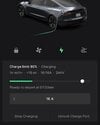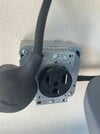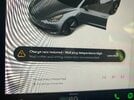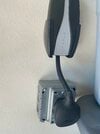So I have had the car for about a year now and home charging has been good up to this point. Typical 240v with 32A. However, recently I noticed the car had less charge than usual in the mornings. I initially brushed it off as plugging it in too late, but noticed last night it started at 32A and then only was using 7A when I woke it. I was able to adjust it back up to 16A, but not any higher. Thoughts? Is this charger related, car related, or thoughts on how to fix it? I haven’t reset the circuit yet to see if that resets anything.
Welcome to Tesla Motors Club
Discuss Tesla's Model S, Model 3, Model X, Model Y, Cybertruck, Roadster and More.
Register
Install the app
How to install the app on iOS
You can install our site as a web app on your iOS device by utilizing the Add to Home Screen feature in Safari. Please see this thread for more details on this.
Note: This feature may not be available in some browsers.
-
Want to remove ads? Register an account and login to see fewer ads, and become a Supporting Member to remove almost all ads.
You are using an out of date browser. It may not display this or other websites correctly.
You should upgrade or use an alternative browser.
You should upgrade or use an alternative browser.
Variable change in ampage during night charging?
- Thread starter Newto3
- Start date
macmovieman
Member
What size breaker are you running? We put an 80 amp breaker in because or typically pulling from two Tesla’s and the GEN3 Tesla connectors can load balance if they’re both on your Wi-Fi. Can you confirm the breaker size?
The car software will do this if it detects a high resistance in the electrical circuit somewhere. Ie. The car thinks there is a wiring problem somewhere along the circuit back to the breaker (and it could also be the breaker dying). I would open up the EVSE if you can (if it is a Wall Connector, obviously you can’t if it is a Mobile Connector), and check/tighten the connections. Do the same with the receptacle if you have one. And do the same back at the breaker panel.
davewill
Active Member
The screen in the car will show two number separated by a slash like "32/32a". The first number is what the car is currently drawing and the second is the max that the EVSE is willing to supply. The second number is important as it can tell us whether the car or the EVSE is the reason that the charge level is limited.
Another issue to toss into the mix: The on-board charger is made up of 16a modules, which have been known to fail one by one. When one fails, the car will suddenly be unable to charge above 32a instead of 48a, or 16a instead of 32a (or even 16a instead of 48a if two modules die). It sometimes starts by intermittently failing first. It's always a good idea to try charging the car at it's maximum rate, especially just before the basic warranty runs out. If you only discover it later, they won't cover it...and they won't detect the problem (or won't tell you about it) if you bring it in for a maintenance service.
I mention it because I find it odd that you're able to dial it back up to 16a and only 16a.
There's a whole thread here full of people with 2018 models who only had a mobile connector at home, and went to charge at 40 or 48a someplace and discovered they couldn't go above 32a.
Another issue to toss into the mix: The on-board charger is made up of 16a modules, which have been known to fail one by one. When one fails, the car will suddenly be unable to charge above 32a instead of 48a, or 16a instead of 32a (or even 16a instead of 48a if two modules die). It sometimes starts by intermittently failing first. It's always a good idea to try charging the car at it's maximum rate, especially just before the basic warranty runs out. If you only discover it later, they won't cover it...and they won't detect the problem (or won't tell you about it) if you bring it in for a maintenance service.
I mention it because I find it odd that you're able to dial it back up to 16a and only 16a.
There's a whole thread here full of people with 2018 models who only had a mobile connector at home, and went to charge at 40 or 48a someplace and discovered they couldn't go above 32a.
davewill
Active Member
Did you unplug and replug in (or stop and restart charging) between the 7/32 and the 16/16?I’ll try to supercharge and take pics of that and what happens tonight. It is odd that it was 32/32 before bed, 7/32 when I woke up and then let me go up to 16/16.
Supercharging has nothing to do with the on-board charger or any of the issues you're trying to troubleshoot. You would want to try a regular wall connector that supports 48a charging. They have them at the service centers and maybe some random destinations. Try www.plugshare.com to search for one.
Last edited:
So I noticed a tote had pressed up against the charger port and it seemed slightly ajar. Reset breaker and ensured fully plugged in. Now pulling 32/32 with 243v so far.
Edit: About 20 minutes later and down to 16/16 244V. Images attached.
Edit: About 20 minutes later and down to 16/16 244V. Images attached.
Attachments
Last edited:
davewill
Active Member
Sounds like what happens when the mobile connector detects a high temperature at the plug. There should be an error message shown in the car when that happens. Doesn't really explain the drop to 7a, though.
Last edited:
I’ll check in a few minutes. So that means get an electrician in to check it out?Sounds like what happens when the mobile connector detects a high temperature at the plug. There should be an error message shown in the car when it happens. Doesn't really explain the drop to 7a, though.
davewill
Active Member
Take a picture of the outlet so we can see what kind it is. The Leviton ones are notorious for overheating. You can also check the temperature of the plug after it's been charging at 32a (after it's slowed to 16a, it will cool down) for a while. Unplug from the car and the outlet and carefully feel the blades on the plug. They should be warm, but not hot. If you can't keep your fingers on them, they're too hot. If you see signs of melting on either the plug or the outlet, it's too hot. You can also remove the cover plate on the outlet (turn off the breaker first) and look for signs of overheating at the connections inside.I’ll check in a few minutes. So that means get an electrician in to check it out?
Thank you so much. There was a message in the car and the biggest part of the plug felt hot, the other two not as bad. Electrician coming Monday and breaker switched off until then.Take a picture of the outlet so we can see what kind it is. The Leviton ones are notorious for overheating. You can also check the temperature of the plug after it's been charging at 32a (after it's slowed to 16a, it will cool down) for a while. Unplug from the car and the outlet and carefully feel the blades on the plug. They should be warm, but not hot. If you can't keep your fingers on them, they're too hot. If you see signs of melting on either the plug or the outlet, it's too hot. You can also remove the cover plate on the outlet (turn off the breaker first) and look for signs of overheating at the connections inside.
Attachments
davewill
Active Member
Have him replace that Leviton outlet with a Hubbell or a Bryant industrial model. It will require a different cover plate and may require a box extension. Pass & Seymour may also be acceptable, but don't let him use another Leviton. If you look directly inside the vertical holes, you'll see the contacts are not brass colored, but steel, and they don't contact the entire width of the blade on both sides. They're basically a house fire waiting to happen.Thank you so much. There was a message in the car and the biggest part of the plug felt hot, the other two not as bad. Electrician coming Monday and breaker switched off until then.
Here's a link to the massive, sticky thread here that figured all this out: Master Thread: Definitive 14-50 NEMA Outlet Guide
So if I order an official Tesla wall charger and have that installed and the old Leviton taken out, would that also work? I know it would be pricey, but for safety sakes, this was a wake up call, especially after seeing some other posts too. I am fortunate a super charger opened up two miles from the house a few weeks ago. So not in a major rush. FWIW, the outlet I had was from a previous owner who had a Leaf. We hadn’t started using that outlet for at least 4 years and couldn’t have been older than another year or so.
davewill
Active Member
That would absolutely work, and might be a better choice, especially if you have a use for carrying the mobile connector. If it's a 50a circuit, it would even net you 40a charging instead of 32a. I'd definitely make sure whether it's a 40a or a 50a circuit before provisioning the wall connector. A lot of those older EVSEs couldn't go over 30 or 32a (or even 16a) at the most, so a 40a circuit was often specified in the install instructions.So if I order an official Tesla wall charger and have that installed and the old Leviton taken out, would that also work? I know it would be pricey, but for safety sakes, this was a wake up call, especially after seeing some other posts too. I am fortunate a super charger opened up two miles from the house a few weeks ago. So not in a major rush. FWIW, the outlet I had was from a previous owner who had a Leaf. We hadn’t started using that outlet for at least 4 years and couldn’t have been older than another year or so.
Last edited:
Similar threads
- Replies
- 5
- Views
- 246
- Replies
- 4
- Views
- 316
- Replies
- 29
- Views
- 1K
- Replies
- 7
- Views
- 412







